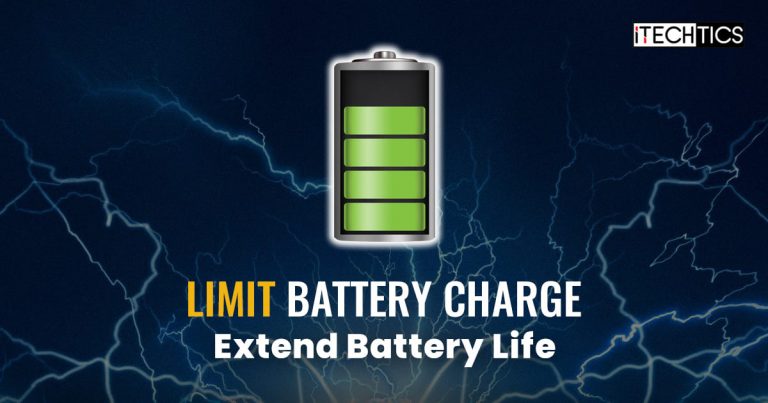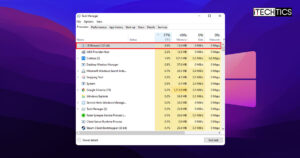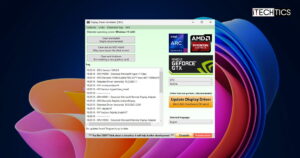With time, you’ll notice that your laptop’s battery has started to degrade and does not offer the same backup time as it used to. This is because all batteries, regardless of their material, tend to lose their ability to retain the charge. Therefore, resulting in a reduced backup time.
If you think that you have the best batteries money can buy and have a significant backup time, your laptop is still prone to losing its backup duration over time. Most modern laptop batteries are made of lithium-ion cells (Li-ion) or lithium-polymer (Li-poly). Even these are prone to slow degradation and eventually you will need to replace them.
Fortunately, there is a method to extend your battery’s life before it is too late, especially if you keep it plugged in most of the time. This can be done by limiting the maximum charging percentage of the battery well below 100% so that it does not overcharge, since leaving the batteries fully charged for long periods tends to damage them in the long run.
Today we are going to show you how to cap your battery’s charging so it does not exceed a certain limit, automatically extending its life. This can be achieved in laptops from the following manufacturers:
Table of Contents
Best Practice to Extend Battery Life
As per research and findings, generic battery consumption should be between 20 and 80%. This keeps the battery from completely draining as well as not being overcharged. However, in the case of laptops, it is said that they should be kept between 40 and 80% for maximum battery efficiency.
Laptop manufacturers also recommend that a laptop battery’s maximum charging state should be kept below 80%, especially if it is plugged into the AC port most of the time. It is also why the power management software by these manufacturers also limits the maximum charge to 80% under certain settings.
How to Limit Battery Charge Threshold in Windows 11/10
Microsoft Windows, or any other operating system for that matter, does not offer the feature to limit the battery’s charging threshold. This is usually controlled either through the system’s BIOS or through the manufacturer’s proprietary power management software. However, the software’s compatibility with the operating system is highly dependent.
Let us now see the methods to limit charging capacity on laptops from different manufacturers.
Limit Battery Charge on Dell Laptops
If you have a laptop from Dell which is frequently plugged into the charging port, then you can limit the charging threshold to extend the battery’s life. Here is how:
-
Start by downloading and installing Dell Power Manager Service from the given link, and then install Dell Power Manager from Microsoft Store.

Get from Microsoft Store -
If prompted, click Open Microsoft Store.

Open Store -
From the Store app, click Get.

Begin installation -
Once installed, open the app and go to the Battery Information tab. Here, click Settings on the right side of the page.

Open battery settings -
Now select “Primarily AC use” and then click Ok.

Set to AC use Note: If you do not see the “Primarily AC use” option, then your device may not be compatible with the settings. If so, unfortunately, there is no other way to limit the charging threshold for your device.
By applying these settings, the device’s charging threshold will be set to 80%.
If you want to charge your device’s battery to 100% in the future, for when you are planning to use it without an AC power source, you can select either “Standard” or “Adaptive” from the options.
Limit Battery Charge on HP Laptops
If you’re using an HP laptop, then you can most likely limit its charging threshold from the system BIOS, if your device supports it. Here are the steps to do so:
-
Restart your computer and then use the Esc or F10 function key to enter the BIOS.
-
Navigate to the “System Configuration” tab and then look for the “Battery Care Function.”
-
You will notice that by default its value is “100%.” Change it to “80%.”
-
Now save the changes and exit BIOS.
Your device will now only charge up to 0% of its total capacity. If you wish to revert these settings in the future, simply change the value for Battery Care Function from the BIOS.
Limit Battery Charge on Lenovo Laptops
If you own a Lenovo laptop, then follow these steps to limit its maximum charging percentage:
-
Download and install the Lenovo Vantage app from Microsoft Store.

Get the app -
Once installed, navigate to the following:
Device >> Power
-
Now turn on “Battery Charge Threshold” by toggling the slider in front of it under the Battery Settings section. When enabled, select the value “80%” from the drop-down menu in front of “Stop charging at.”

Lenovo battery settings -
Also, select a charging value from the drop-down menu in front of “Start charging when below.” The recommended value for this is 40%, but you can also set it according to your preference.
Once this configuration is done, your battery’s charge percentage will remain between the configured values.
If you wish to charge your Lenovo laptop to 100% again, simply turn off the “Battery Charge Threshold” feature.
Limit Battery Charge on Microsoft Surface Laptops
If you’re using a Surface laptop, then you can enable battery limiting through its UEFI settings. However, Surface laptops do not allow you to configure the threshold but only enable or disable the feature.
When it is enabled, the device’s battery will only charge to a maximum of 50%.
Before you go about changing these settings, confirm that your device is supported. Here is a list of the supported devices:
- Surface Pro 7 and later
- Surface Laptop 3 and later
- Surface Book 3
- Surface Laptop Studio
- Surface Laptop Go
- Surface Laptop Go 2
- Surface Studio 2
- Surface Laptop SE
To enable the feature, simply toggle the slider in front of “Enable battery limit mode” in the Advanced options settings to the on position.

If you’re using a model not mentioned in the list above, refer to this Microsoft post to learn how to enable it on your device.
Limit Battery Charge on Asus Laptops
Asus also offers a proprietary application to manage its power settings. Follow these steps to limit your device’s maximum battery charging capacity and increase its longevity:
Note: Check if your device is supported on Asus’s website.
-
Download and install the MyASUS app from Microsoft Store.
-
Once it is installed, open the app and navigate to the following:
Customization >> Power & Performance
-
Here, select either one of the following options under “Battery Health Charging“
- Balanced Mode: The maximum charge percentage is set to 80% and the laptop starts to charge at 78%.
- Maximum Lifespan Mode: The maximum charge percentage is set to 60% and the laptop starts to charge at 58%.
This will now limit your device’s charging at the value according to the selected option.
If you wish to change its maximum charging capacity to 100%, simply select “Full Capacity Mode” from the MyASUS app in front of “Battery Health Charging.”
To learn more about ASUS Battery Health Charging, here is a complete guide.
Final Thoughts
It is always better to take precautions before leading to mishaps, or in this case, before your device’s battery expires prematurely. By setting a cap on the maximum charging limit on your laptop’s battery, you can ensure that it does not retain its full charging capacity for prolonged hours and does not swell up, thus ensuring its longevity.
Frequently Asked Questions (FAQs)
How to limit battery charge in Windows 11/10?
The Windows operating itself does not provide a solution to limit the maximum charging capacity of your laptop. However, the laptop manufacturers provide proprietary software to control the device’s power management, or in some cases, can be controlled through the system BIOS.
Is it safe to limit battery charging capacity?
Yes, it is entirely safe and revertable, if required. Limiting the charging capacity can be beneficial for the battery itself as it increases its life. Although charging the battery to its full potential (100%) is not harmful, keeping it fully charged all the time can make it swell up and lose its charge rather quickly.
Limiting its charge will ensure that that does not happen, especially if your laptop is mostly plugged into an AC power port.
Why does the laptop’s battery fluctuate between 2 percentages?
Some laptops tend to charge and discharge the battery according to the configured lower and upper limits. For example, you can configure a supported Lenovo laptop to stop charging when it reaches 80% and begins charging when it reached 75%. This way, the battery percentage will fluctuate between these 2 values when the laptop is plugged in.








